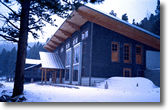 Winter Ecology - Week I
Winter Ecology - Week I
WEEKLY
SCHEDULE AND READINGS
WEEK 1: Midweek, Sat, Sat eve, Sun | WEEK 2 | WEEK 3 | WEEK 4 | WEEK 5 | WEEK 6 |RETURN TO SYLLABUS
(Schedules etc. subject
to modification)
N.B. -
- Written assignment
based on readings due Saturday at 8.30a.
- Individual projects: Initial Ideas due Sunday
at 5p.
Week I
Wednesday
5:00p - On-campus lecture meeting (Ramaley N183)
Lecture:
Winter Climate Mountain winter climates
(light, thermal, moisture, wind regimes) · Dynamics of
mid-latitude winter storms
| Handouts/Notes |
- Physical Setting
& Climate lecture handout (color: pdf
/ B&W: pdf,
2M)
- Lecture-related
notes: Four sources of winter precipitation
(ppt) in the Colorado Front Range:
1) Mid-latitude cyclonic storms arriving from the
West, with Warm Front/Cold Front structure
2) Orographic ppt on the Westerlies, spilling over the
Divide - favors higher elevations, especially near
Divide, little ppt below Pk-to-Pk hwy. Also
favors wind loading from the N/NW.
3) Upslope ppt from a "Four-Corners' Low" - usually
has high ppt amounts pulling 'warm' moist air from
south, similar with elevation on East Slope or even
greater in Boulder. Larger flakes.
4) "Arctic Blast" - small amounts ppt because very
cold, 'dry' air; starts out as shallow air layer,
pushing up Front Range canyons. Small flakes.
Often more ppt favored at lower elevations, depends on
depth and moisture of Arctic air.
Notes:
- (3) and (4) are also
orographically-induced (as 2), just that flow is
from East. Cyclonic storms (in 1) are
orographically-enhanced, but primary mechanism is
the storm's cold front/warm front
circulation.
- Cyclonic storms are also
enhanced as in (3) by circulation of warm, moist air
from south - difference is that in (3) the storm
itself is too far to the south, not overhead as in
(1).
- In summer also can add
5th & 6th precipitation mechanisms with (5)
local convection developing along the Divide (with
moisture drawn up from the Plains) and (6) monsoonal
flow from the S and SW into the continent center,
and interacting with the mountains
|
Lesson points: Climate
|
- How do global, continental,
regional, local position determine climate?
- What are the main mechanisms
that generate wintertime precipitation?
- What are the main processes that
determine surface temperature (of the air, of the
surface of a tree/mammal)?
|
Additional
Resources
|
from
https://en.wikipedia.org/wiki/Orographic_lift:
The leeward edge of an extensive mass of orographic clouds
may be quite distinct. On the leeward side of the mountain,
the air flowing downward is known as a foehn wind. Because some of the
moisture has condensed on the top of the mountain, the foehn
(or föhn) is drier, so any suspended moisture quickly
evaporates as the air descends.
The distinct cut-off line which forms along and parallel to
the ridge line is sometimes known as a foehn wall
(or föhn wall). This is because the edge appears
stationary and it often appears to have an abrupt wall-like
edge. A foehn wall is a common feature along the Front Range
of the Colorado Rockies.[1] |
Prep
for Weekend --
|
Additional Gear to Bring
for this weekend
for
Saturday and Sunday field work
|
|
|
Readings &
Lesson points
&
Assignments
|
Readings - LC =Life in the Cold,
4th ed
"4
Questions" Written Assignment
(due Saturday 1st thing)
-- Turn in 1st weekend's Saturday
morning:
- Develop 4 questions about winter ecology
that sparks your curiosity based on LC
Chapter 1,
- for these 4, base at least 1 question on
each section
Project initial question
(due Sunday)
|
|
Saturday Mountain Research Stn
Current Weather
& Forecasts
8:00a
Arrive · Check-in ·
Late registration/Late tuition payment
8:15a Orientation
- Site logistics:
MRS Station Manager
- Safety
- Introduction to the
study area
| Handouts |
|
| MRS links |
|
| Niwot Ridge links |
|
| Resources |
|
8:30a 5p Link To: SNOWPACK FIELD DAY (Schedule,
Readings, What to Bring)
5:00p Group Dinner Prep
6:00p Group
Dinner
7:15p Link To:
EVENING
PROGRAM: Avalanche
Dynamics and Safety Ethan
Davis, Colorado Avalanche Information Center
(CAIC)
- Link includes
Presentation and Other Resources
Sunday
Current Weather
& Forecasts
8:30a-1:30p Link
To: WINTER
SOIL BIOLOGY FIELD DAY (Schedule, Readings, What to Bring)
1:30-3:00p
Walkabout: Winter
Ecology Biological Setting
- Key to MRS Conifers (pdf,
600k)
- Photographic Guide to
Common Conifers of the Colorado Front Range - Gwen Kittel (pdf,
1M)
3:00-5:00p
Individual
projects
- Instructor consultation
5:00p
Individual
projects:
Initial Ideas due - one
sentence
5:00p - Departure
Course website including all internal
links © 2016 T.
Kittel. All rights reserved. All copyrighted
material on this website is made available for limited
educational use only (commercial use strictly prohibited).
rev. 25 Jan 16
 Winter Ecology - Week I
Winter Ecology - Week I
